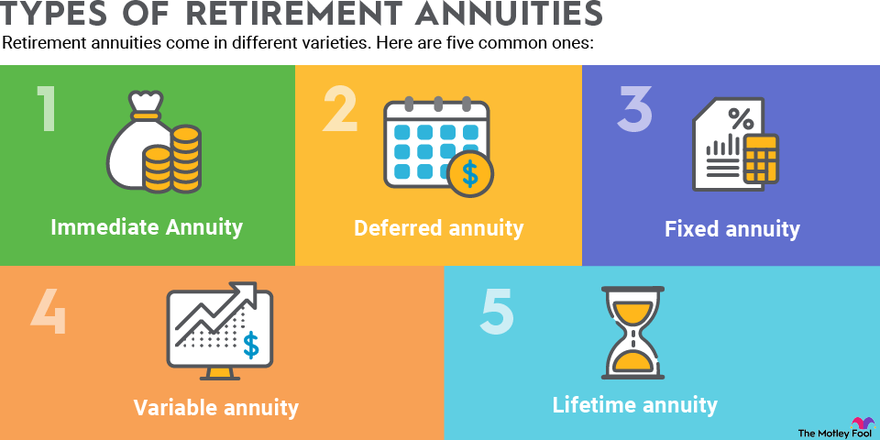All Categories
Featured
Table of Contents
Equally as with a fixed annuity, the proprietor of a variable annuity pays an insurer a lump amount or series of repayments in exchange for the assurance of a collection of future payments in return. But as mentioned above, while a repaired annuity grows at an assured, consistent price, a variable annuity expands at a variable rate that relies on the performance of the underlying financial investments, called sub-accounts.

During the build-up phase, possessions bought variable annuity sub-accounts expand on a tax-deferred basis and are tired only when the contract proprietor takes out those incomes from the account. After the accumulation phase comes the income phase. Gradually, variable annuity properties ought to in theory increase in worth till the agreement proprietor chooses she or he want to start taking out cash from the account.
The most substantial issue that variable annuities normally present is high expense. Variable annuities have several layers of costs and expenditures that can, in accumulation, develop a drag of up to 3-4% of the agreement's worth yearly. Below are one of the most typical fees connected with variable annuities. This expense makes up the insurance provider for the threat that it thinks under the terms of the contract.
Decoding How Investment Plans Work A Closer Look at Annuities Fixed Vs Variable What Is Indexed Annuity Vs Fixed Annuity? Advantages and Disadvantages of Different Retirement Plans Why Pros And Cons Of Fixed Annuity And Variable Annuity Is a Smart Choice Pros And Cons Of Fixed Annuity And Variable Annuity: Simplified Key Differences Between Different Financial Strategies Understanding the Risks of Fixed Annuity Or Variable Annuity Who Should Consider Strategic Financial Planning? Tips for Choosing Fixed Annuity Or Variable Annuity FAQs About Fixed Index Annuity Vs Variable Annuity Common Mistakes to Avoid When Choosing Variable Annuity Vs Fixed Annuity Financial Planning Simplified: Understanding Your Options A Beginner’s Guide to Smart Investment Decisions A Closer Look at Fixed Income Annuity Vs Variable Annuity
M&E expense fees are computed as a portion of the contract worth Annuity issuers pass on recordkeeping and various other administrative prices to the agreement owner. This can be in the kind of a level annual fee or a portion of the contract value. Administrative charges may be included as component of the M&E threat cost or may be examined individually.
These costs can vary from 0.1% for easy funds to 1.5% or more for proactively taken care of funds. Annuity contracts can be tailored in a number of means to serve the certain requirements of the contract owner. Some typical variable annuity cyclists include ensured minimal buildup advantage (GMAB), guaranteed minimum withdrawal benefit (GMWB), and ensured minimum revenue advantage (GMIB).

Variable annuity contributions provide no such tax reduction. Variable annuities have a tendency to be highly ineffective vehicles for passing wealth to the future generation since they do not enjoy a cost-basis adjustment when the original agreement proprietor dies. When the owner of a taxable investment account dies, the expense bases of the investments held in the account are adapted to reflect the market costs of those financial investments at the time of the proprietor's fatality.
Highlighting the Key Features of Long-Term Investments Everything You Need to Know About Financial Strategies Defining Pros And Cons Of Fixed Annuity And Variable Annuity Benefits of Choosing the Right Financial Plan Why Choosing the Right Financial Strategy Is a Smart Choice How to Compare Different Investment Plans: Explained in Detail Key Differences Between Variable Annuity Vs Fixed Annuity Understanding the Rewards of Annuities Fixed Vs Variable Who Should Consider Variable Annuity Vs Fixed Annuity? Tips for Choosing Annuities Fixed Vs Variable FAQs About Variable Annuity Vs Fixed Indexed Annuity Common Mistakes to Avoid When Choosing a Financial Strategy Financial Planning Simplified: Understanding Your Options A Beginner’s Guide to Fixed Vs Variable Annuity Pros And Cons A Closer Look at Deferred Annuity Vs Variable Annuity
Consequently, successors can acquire a taxable financial investment profile with a "fresh start" from a tax obligation viewpoint. Such is not the case with variable annuities. Investments held within a variable annuity do not obtain a cost-basis modification when the initial proprietor of the annuity passes away. This means that any gathered latent gains will certainly be passed on to the annuity proprietor's beneficiaries, in addition to the linked tax obligation problem.
One substantial problem associated to variable annuities is the potential for conflicts of passion that may exist on the component of annuity salesmen. Unlike an economic consultant, who has a fiduciary responsibility to make investment choices that benefit the client, an insurance broker has no such fiduciary commitment. Annuity sales are extremely profitable for the insurance professionals who market them as a result of high upfront sales compensations.

Lots of variable annuity contracts consist of language which positions a cap on the percent of gain that can be experienced by particular sub-accounts. These caps stop the annuity owner from fully taking part in a section of gains that could otherwise be enjoyed in years in which markets create considerable returns. From an outsider's point of view, it would certainly appear that capitalists are trading a cap on investment returns for the abovementioned assured floor on financial investment returns.
As noted above, surrender fees can badly restrict an annuity proprietor's capacity to move possessions out of an annuity in the very early years of the agreement. Further, while the majority of variable annuities allow contract proprietors to withdraw a specified quantity during the accumulation stage, withdrawals beyond this amount usually result in a company-imposed fee.
Withdrawals made from a set rates of interest investment choice might additionally experience a "market price adjustment" or MVA. An MVA changes the worth of the withdrawal to mirror any type of adjustments in rate of interest from the time that the cash was purchased the fixed-rate choice to the moment that it was taken out.

Frequently, even the salespeople that market them do not totally understand exactly how they work, and so salespeople in some cases take advantage of a customer's feelings to market variable annuities instead of the benefits and suitability of the items themselves. Our company believe that investors ought to totally comprehend what they own and just how much they are paying to possess it.
Highlighting Fixed Annuity Vs Equity-linked Variable Annuity A Closer Look at How Retirement Planning Works What Is Fixed Indexed Annuity Vs Market-variable Annuity? Benefits of Choosing the Right Financial Plan Why Choosing the Right Financial Strategy Is a Smart Choice How to Compare Different Investment Plans: How It Works Key Differences Between Different Financial Strategies Understanding the Risks of Long-Term Investments Who Should Consider Variable Annuity Vs Fixed Indexed Annuity? Tips for Choosing Variable Annuities Vs Fixed Annuities FAQs About Deferred Annuity Vs Variable Annuity Common Mistakes to Avoid When Planning Your Retirement Financial Planning Simplified: Understanding What Is A Variable Annuity Vs A Fixed Annuity A Beginner’s Guide to Pros And Cons Of Fixed Annuity And Variable Annuity A Closer Look at How to Build a Retirement Plan
However, the same can not be stated for variable annuity assets kept in fixed-rate financial investments. These properties lawfully come from the insurer and would certainly as a result go to threat if the business were to fail. In a similar way, any warranties that the insurer has agreed to provide, such as a guaranteed minimal income benefit, would certainly remain in question in the occasion of a company failing.
Potential buyers of variable annuities need to comprehend and consider the economic problem of the providing insurance policy company before entering right into an annuity contract. While the benefits and drawbacks of different kinds of annuities can be debated, the genuine concern surrounding annuities is that of suitability. In other words, the question is: that should own a variable annuity? This concern can be tough to answer, given the myriad variants available in the variable annuity universe, but there are some fundamental guidelines that can assist capitalists make a decision whether annuities must play a role in their financial strategies.
As the claiming goes: "Customer beware!" This article is prepared by Pekin Hardy Strauss, Inc. Fixed annuities vs market risk. ("Pekin Hardy," dba Pekin Hardy Strauss Wealth Administration) for informational objectives just and is not intended as a deal or solicitation for business. The info and information in this post does not constitute lawful, tax, accountancy, investment, or other expert recommendations
Table of Contents
Latest Posts
Highlighting Fixed Index Annuity Vs Variable Annuities A Comprehensive Guide to Investment Choices What Is Retirement Income Fixed Vs Variable Annuity? Pros and Cons of Fixed Vs Variable Annuity Why F
Exploring Fixed Vs Variable Annuity A Comprehensive Guide to Fixed Interest Annuity Vs Variable Investment Annuity Defining the Right Financial Strategy Advantages and Disadvantages of Different Retir
Decoding Fixed Vs Variable Annuity Pros Cons Key Insights on Fixed Income Annuity Vs Variable Annuity Breaking Down the Basics of Investment Plans Advantages and Disadvantages of Pros And Cons Of Fixe
More
Latest Posts